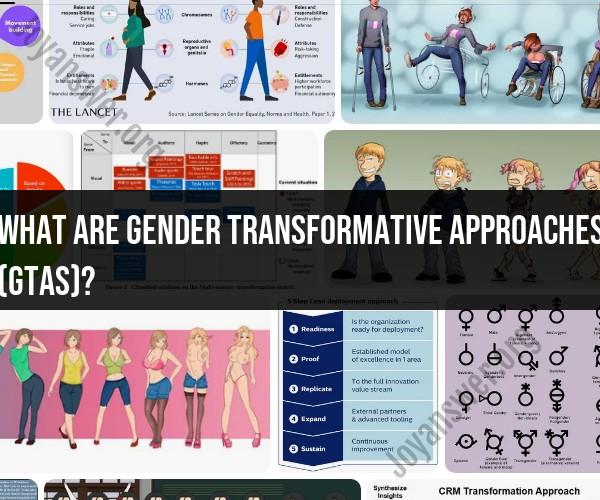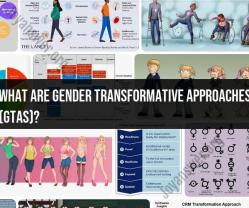What are Gender transformative approaches (GTAs)?
Gender Transformative Approaches (GTAs) are strategies, programs, and interventions designed to challenge and change deeply ingrained gender norms and inequalities in order to promote gender equality and empower individuals of all genders. These approaches recognize that traditional gender roles and expectations can be harmful and limiting, and they aim to transform these norms to create a more equitable society. Here are some key aspects of Gender Transformative Approaches:
Critical Examination of Gender Norms: GTAs involve a critical examination of societal norms and expectations related to gender. They question and challenge traditional stereotypes and roles that can lead to discrimination and unequal opportunities.
Empowering Both Genders: These approaches focus on empowering individuals of all genders, not just women or marginalized genders. They recognize that rigid gender norms and expectations can harm both men and women and that transformation is beneficial for everyone.
Promoting Equality and Justice: The ultimate goal of GTAs is to promote gender equality and justice in all aspects of life, including social, economic, and political spheres. This involves addressing issues like unequal pay, gender-based violence, and limited access to education and healthcare.
Community Engagement: GTAs often work at the community level, involving local leaders, activists, and organizations. Community engagement is crucial for changing norms and behavior.
Education and Awareness: Education and awareness-raising campaigns play a significant role in GTAs. These programs aim to change attitudes and beliefs by providing information about gender issues and their consequences.
Behavioral Change: GTAs seek to transform behavior by encouraging individuals to question their own actions and biases. They promote respectful and equitable interactions between people of different genders.
Policy and Institutional Change: These approaches may also advocate for changes in policies, laws, and institutions to support gender equality. This can include measures to address workplace discrimination, promote gender-sensitive education, and ensure access to healthcare for all.
Long-Term and Sustainable Change: Gender transformation is seen as a long-term and ongoing process. It's not just about immediate changes but creating sustainable shifts in societal norms and structures.
Collaboration and Partnerships: GTAs often involve collaboration between various stakeholders, including government agencies, civil society organizations, and international bodies. These partnerships help to address gender inequality on multiple levels.
Measuring Impact: Evaluating the impact of Gender Transformative Approaches is essential to track progress and make necessary adjustments to interventions. This may involve collecting data on changes in gender-related attitudes, behaviors, and outcomes.
GTAs are used in various fields, including healthcare, education, development, and social justice, to challenge gender inequality and promote a more inclusive and equitable world. They acknowledge that achieving gender equality requires addressing the root causes of discrimination and bias.
Exploring Gender Transformative Approaches (GTAs) in Social Change
Gender transformative approaches (GTAs) are a set of strategies and methods that aim to challenge and transform the underlying causes of gender inequality. GTAs are based on the understanding that gender is not just a biological difference between men and women, but also a social construct that shapes our experiences, opportunities, and limitations.
GTAs are unique in that they focus on both the individual and the collective levels of change. At the individual level, GTAs seek to empower women and girls to challenge harmful gender norms and stereotypes. At the collective level, GTAs work to transform the social, economic, and political structures that perpetuate gender inequality.
The Role of GTAs in Promoting Gender Equality
GTAs play an important role in promoting gender equality by:
- Challenging harmful gender norms and stereotypes.
- Empowering women and girls to make their own decisions and control their own lives.
- Promoting gender-equitable practices and policies in all areas of society.
- Addressing the root causes of gender inequality, such as poverty, discrimination, and violence against women and girls.
GTAs have been used successfully in a variety of contexts to achieve gender equality, including:
- Economic empowerment: GTAs have been used to help women and girls gain access to education, employment, and financial resources.
- Political participation: GTAs have been used to help women and girls participate in political and decision-making processes.
- Sexual and reproductive health and rights: GTAs have been used to help women and girls access sexual and reproductive health services and information, and to make their own decisions about their bodies and lives.
- Ending violence against women and girls: GTAs have been used to prevent and respond to violence against women and girls, and to support survivors of violence.
Implementing GTAs: Strategies for Empowering Women and Girls
There are a number of strategies that can be used to implement GTAs. Some common strategies include:
- Raising awareness and understanding of gender inequality: This is essential for creating a supportive environment for change.
- Building capacity and skills: Women and girls need to be equipped with the knowledge and skills they need to challenge harmful gender norms and stereotypes and to make their own decisions about their lives.
- Creating safe spaces: Women and girls need to have safe spaces where they can feel comfortable talking about their experiences and exploring their options.
- Promoting gender-equitable practices and policies: This can be done at the individual, household, community, and institutional levels.
- Advocating for change: This is important for creating a more gender-equitable society.
GTAs are a complex and challenging area of work, but they are essential for achieving gender equality. By implementing GTAs, we can create a more just and equitable world for all.


